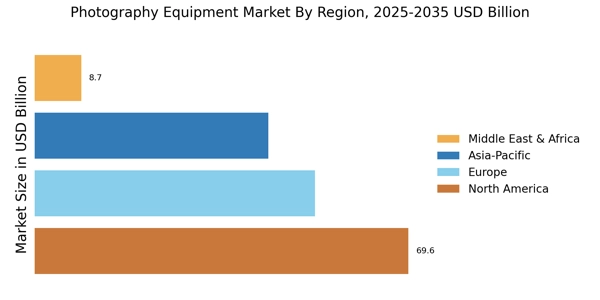Expansion of E-commerce Platforms
The Photography Equipment Market is experiencing a transformation due to the expansion of e-commerce platforms. As consumers increasingly prefer online shopping for convenience and variety, photography equipment sales through digital channels are on the rise. Market data indicates that e-commerce sales in the photography sector have seen a substantial increase, with projections suggesting a growth rate of over 12% annually. This shift not only allows consumers to access a wider range of products but also enables manufacturers to reach a broader audience without the constraints of physical retail spaces. Additionally, the rise of direct-to-consumer models is empowering brands to establish closer relationships with their customers. This evolving landscape indicates that the Photography Equipment Market is likely to continue adapting to the preferences of modern consumers, further driving sales and innovation.
Rise of Online Learning and Workshops
The Photography Equipment Market is witnessing a rise in online learning platforms and workshops, which are fostering a new generation of photographers. As individuals seek to enhance their skills, they are increasingly turning to online courses that often recommend specific equipment for optimal results. This trend is supported by data indicating that the online education market is expected to grow significantly, with photography courses being a substantial segment. Consequently, as learners invest in their education, they are likely to purchase new photography equipment to practice and apply their skills. This creates a symbiotic relationship between education and equipment sales, suggesting that the Photography Equipment Market will benefit from the growing interest in photography as a hobby and profession. The accessibility of online resources is likely to further stimulate demand for various photography tools.
Adoption of Advanced Imaging Technologies
The Photography Equipment Market is significantly influenced by the rapid adoption of advanced imaging technologies. Innovations such as high-resolution sensors, improved autofocus systems, and enhanced image stabilization are transforming the landscape of photography. For instance, the introduction of 8K video capabilities in cameras has expanded the creative possibilities for filmmakers and photographers alike. This technological evolution is reflected in market data, indicating that the segment for high-end cameras is projected to grow at a compound annual growth rate of over 10% in the coming years. As consumers become more tech-savvy, their expectations for photography equipment rise, prompting manufacturers to invest in research and development. This trend not only enhances the user experience but also positions the Photography Equipment Market for sustained growth as it adapts to the demands of a more discerning audience.
Increased Demand for High-Quality Content
The Photography Equipment Market experiences a notable surge in demand for high-quality content across various sectors, including social media, advertising, and e-commerce. As businesses increasingly recognize the importance of visual storytelling, the need for advanced photography equipment becomes paramount. This trend is evidenced by the projected growth rate of the photography equipment market, which is expected to reach approximately 15 billion dollars by 2026. The proliferation of platforms that prioritize visual content further fuels this demand, compelling both amateur and professional photographers to invest in superior equipment. Consequently, manufacturers are responding by innovating and enhancing their product offerings, ensuring they meet the evolving needs of consumers. This dynamic environment suggests that the Photography Equipment Market will continue to thrive as content creators seek tools that enable them to produce visually compelling narratives.
Growing Interest in Photography as a Hobby
The Photography Equipment Market is benefiting from a growing interest in photography as a hobby among diverse demographics. As more individuals seek creative outlets, photography has emerged as a popular choice, leading to increased sales of entry-level and mid-range equipment. Market data suggests that the segment for consumer cameras is projected to grow steadily, with a notable rise in sales of compact and mirrorless cameras. This trend is further supported by the proliferation of social media platforms that encourage users to share their photographic endeavors. As hobbyists invest in photography equipment to enhance their skills and share their work, the market is likely to see sustained growth. This burgeoning interest indicates that the Photography Equipment Market will continue to thrive as it caters to the needs of aspiring photographers.


















Leave a Comment